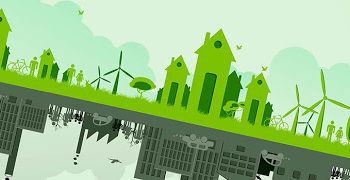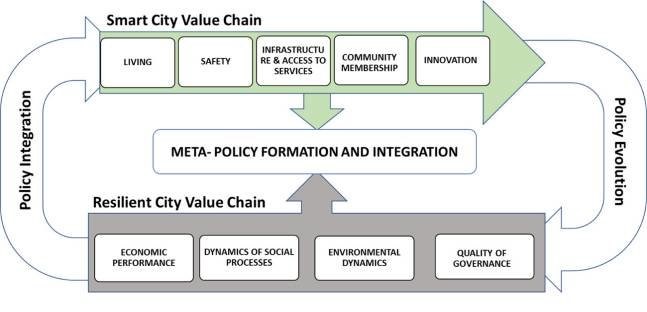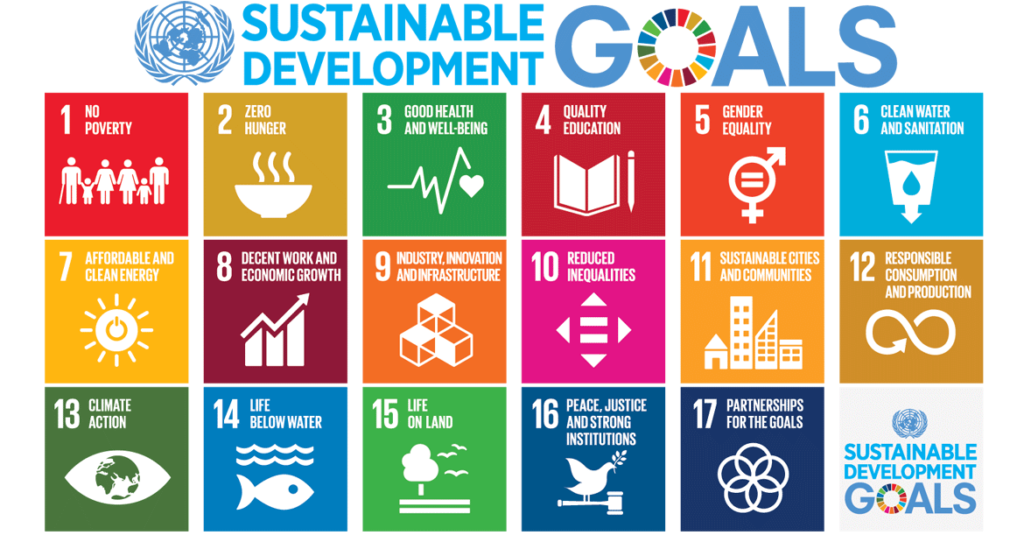
A universal right: have access to safe drinking water
I
n 2015, the United Nations General Assembly set up 17 Sustainable Development Goals (SDG) to “achieve a better and more sustainable future for all” by 2030. The SDGs are globally interlinked and include, among others, the end of poverty in all its forms, reduction of inequalities, climate actions, and a turn into more affordable and sustainable energy. In particular, SDG 6 focuses on ensuring availability and sustainable management of water and sanitation for all. Figure 1 shows the six key targets and the two additional targets for resource mobilisation and policy to be achieved within SDG 6 [1]. Access to safe drinking water and sanitation is essential for the realisation of all human rights and the development of life. However, despite the growing involvement of all countries, there is still a long way to go. In 2020, billions of people still lacked access to safe drinking water, sanitation, and hygiene [2].
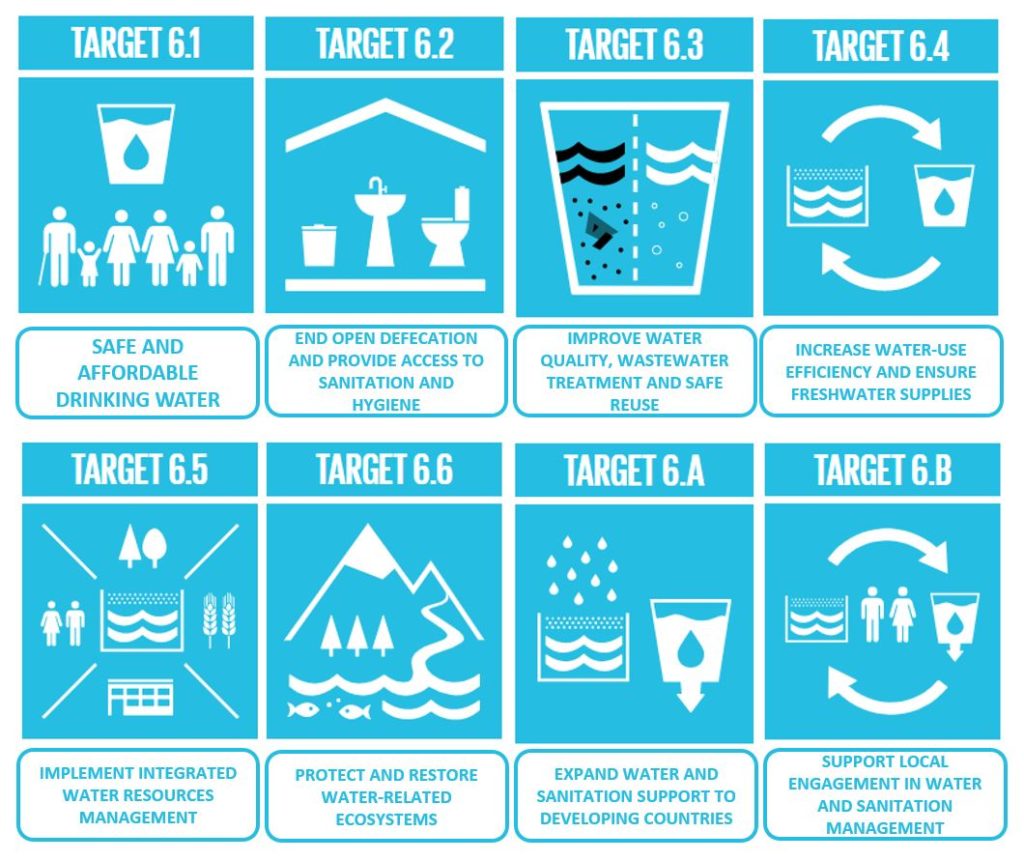
Water and sanitation are at the core of sustainable development since they would help at the same time poverty reduction, economic growth, and environmental sustainability [3]. Nevertheless, overexploitation, pollution, and climate change have led to severe water stress in places across the world, worsening the situation with increasing disasters such as floods and droughts. 80% of wastewater in the world flows back into the ecosystem without being treated or reused, and 70% of the world’s natural wetland extent has been lost due to anthropogenic causes, including a significant loss of freshwater species. The consequences of lack of safe water are lethal: according to the UN’s 2018 annual report on the SDGs, around a thousand children die every day due to diseases related to poor hygiene and quality water [4].
Moreover, COVID-19 pandemic posed an additional impediment in accessing safe water and other sanitation and hygiene services, which on the other hand, were needed to prevent the spreading of the virus [5].
Household water treatments and safe storage (HWTS)
Most of the population without access to safe water is in developing countries where lack infrastructure and financial resources. Providing access through centralised systems would indeed be very challenging. Large distribution systems involve a lot of operation and maintenance, and water can get contaminated during the distribution or handling in the household [6]. Low-cost, easy-to-use and sustainable domestic treatments are needed in these locations. Household-level Water Treatment and Safe Storage (HWTS) is the most cost-effective intervention that vulnerable populations can rapidly implement in developing countries to improve microbial water quality and reduce waterborne diseases [7]. HWTS is a multi-barrier approach with 5 steps that equally contribute to reducing the risk of unsafe water (shown in Figure 2). The multi-barrier approach is the best way to minimise the threats coming from drinking unsafe water. Waterborne pathogens can be eliminated by household water treatment like boiling, chlorination, separation with specific ceramic filters (filtration) or adding chemical coagulants to agglomerate the pathogens, settle them and separate them (flocculation). Relying on more than one technology to improve water quality is key to ensuring high decontamination from protozoa, bacteria, and viruses and reducing the health risks associated with them.

Source protection
Actions should be taken to improve the water sources or points of collection. This can include regular cleaning of the area around, moving latrines away or downstream, and building fences to prevent animals from contaminating open water sources.
Sedimentation
Gravity settling is the simplest household water treatment and safe storage (HWTS) method. It removes some turbidity and improves the visual appearance, although it is limited in pathogen removal and can be affected by secondary contamination. Coagulation enhances settling making the particles stick to each other. However, coagulation is affected by several factors such as temperature, pH, and coagulant dose. Sedimentation alone is not a complete treatment but allows subsequent treatment steps to be more effective.
Filtration
Membrane filtration is a rapidly growing field in water treatment. There are different kinds of membranes based on size exclusion mechanism, electrostatic effect and biological activity. The main configurations include dead-end, cross-flow, flat sheet, and hollow fibres, and they provide a good barrier to particles, protozoa, bacteria, and viruses. It has a simple operation without affecting the taste and reduces turbidity. However, the main drawback is the membrane fouling, which results from particle retention, and increases the operating pressure. Fouling can be reversible or irreversible but can be limited by regular backwashing and periodic cleaning. Also, filtration does not protect against recontamination.
Ceramic filtration consists of ceramic pot filters and candle filters. It has a simple operation and can be produced locally without electricity. It is also socially accepted and highly used in developing countries. However, it has moderate effectiveness, variable water quality, and no residual protection.
Biological filtration mainly includes biosand or slow sand filtration. The biological layer takes time to develop, but it does not need backwashing, although other cleanings may be needed. It’s possible a long-term use, but there is a high risk of recontamination.
Disinfection
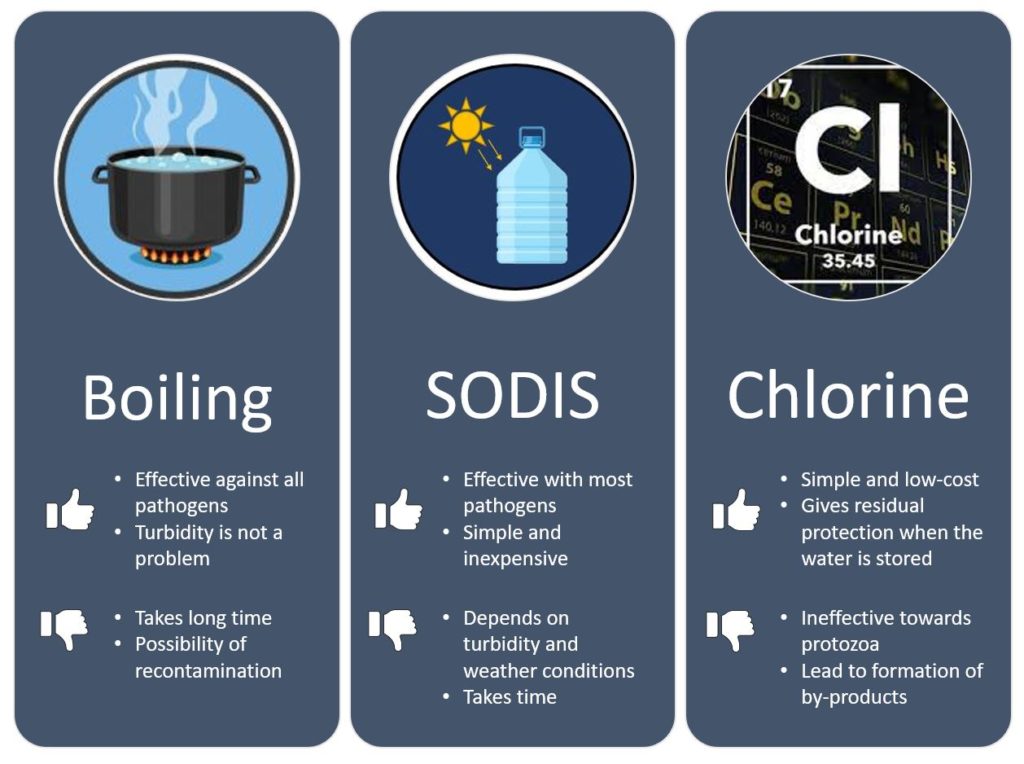
Heat is the oldest HWTS, and it is widely accepted, understood, and promoted. Boiling water is effective against all viruses, bacteria, and protozoa, and turbidity is not a problem. However, it takes a long time if we include cooling, and there is a high possibility of recontamination.
Ultraviolet radiation is effective with most bacteria, protozoa, and viruses and can be artificial or natural. The dose is calculated as intensity*time, and typical doses consist of 400 J/m2. UV-C lamps can act directly on the DNA while using natural sunlight through the Solar Disinfection process (SODIS) we can exploit the UV-A and UV-B spectra of the sun. SODIS consists of exposing PET bottles for 6 hours in good weather conditions. UV treatment is highly effective and, in the case of SODIS, is also simple and inexpensive. However, it takes time and depends on turbidity. Furthermore, when using sunlight is highly dependent on climate conditions.
Chlorine is a chemical disinfection and the second most reported HWTS. Chlorine is a strong oxidant and acts on the cell wall, DNA, and enzymes. It is highly effective, other than simple to use and low cost. Furthermore, it gives residual protection when the water is stored. The main drawbacks are the change in the taste and odour, the ineffectiveness against protozoa at small concentrations, and the formation of by-products.
Safe Storage
Even if household drinking water is treated, it may still become re-contaminated through storage in dirty or uncovered containers or through contact with dirty hands and utensils. Appropriate containers are designed to minimise recontamination. Hygienic location is also important as environmental contamination can easily affect the final water quality. The containers should have a lid or be narrow-necked to limit recontamination.
ESCAPE ROOM: Save the population from water scarcity

In the following link you have access to my escape room about water treatment. Learn more about it, challenge yourself to solve the riddles, and find the key to saving the population from water scarcity.

https://docs.google.com/presentation/d/1Bc6ZaYtM_e_o8kQ3DOKal53YA2nkU0IUqI_kIAJQbG4/preview#slide=id.gf90f95fc23_0_2 (in English)

https://docs.google.com/presentation/d/1a88X7-rcjRJbMdSVzlThhoMJRbf0NeIudHxO3d2cMVo/preview#slide=id.gf90f95fc23_0_2 (in Spanish)
References
[1] Goal 6: Clean Water and Sanitation. Available at: https://www.globalgoals.org/6-clean-water-and-sanitation (accessed December 12, 2021).
[2] Goal 6: Department of Economic and Social Affairs. Available at: https://sdgs.un.org/goals/goal6 (accessed December 16, 2021).
[3] Water and Sanitation: Department of Economic and Social Affairs. Available at: https://sdgs.un.org/topics/water-and-sanitation (accessed December 14, 2021).
[4] UN Environment 2018 Annual Report – UN Environment Programme. Available at: https://www.unep.org/resources/un-environment-2018-annual-report (accessed December 16, 2021).
[5] UN Environment 2021 Annual Report – UN Environment Programme. Available at: https://www.un.org/annualreport/index.html (accessed December 12, 2021).
[6] Household Water Treatment and Safe Storage (HWTS). SSWM – Find tools for sustainable sanitation and water management! Available at: https://sswm.info/sswm-solutions-bop-markets/affordable-wash-services-and-products/affordable-water-supply/household-water-treatment-and-safe-storage-%28hwts%29 (accessed December 16, 2021).
[7] The International Network to Promote Household Water Treatment and Safe Storage. Available at: https://www.who.int/household_water/advocacy/combating_disease.pdf (accessed December 13, 2021).
